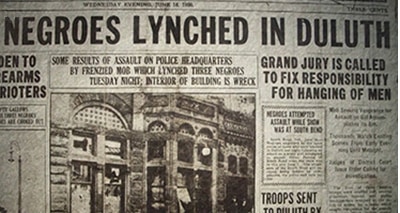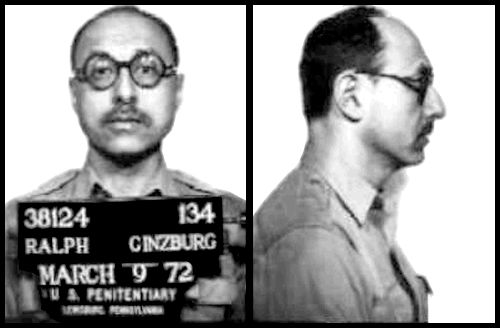Lynching Porn
Jane Weir, American Renaissance, September 15, 2022

Lynching stories hold a central place in the history of American race politics. They are a genre of folklore, somewhere between “urban legends” and tales of wartime atrocities. When we see references to Emmett Till, or Ahmaud Arbery, or George Floyd, or Willie McGee [1] as “lynching victims,” it’s easy to dismiss the hyperbole as just one more tiresome invocation of victim culture.
But there is a deeper significance here. Stories of extreme cruelty meted out to a black victim — torture, immolation, mutilation — have been the main driver behind American race politics of the past century. “Justice,” “equality,” “civil rights” — those goals are merely the noble-sounding face of black activism, a movement that will never be satisfied (there’s never enough justice; never enough equality). What the movement is really all about — what it’s always been about — is anger and destructiveness, fueled by a never-ending, self-perpetuating cycle of Lynching Porn.
In calling it “porn,” I don’t mean to imply that there’s an erotic component to lynching stories. Rather, I’m comparing it to such things as “snuff films” and “torture porn.” As you’ll see, the resemblance is striking. Another analogy: From a financial angle, pornography was the main driver of the World Wide Web 20 years ago and probably is even now. (Here’s an informative BBC business story about it from 2019.) Meanwhile, even a cursory survey of the past 160 years finds Lynching Porn as the main fuel for race politics and civil rights agitation. Anyone who doubts this need only stroll over to the prurient-minded Equal Justice Initiative. The EJI is one of innumerable organizations full of cant about fighting “racial injustice” and “racial inequality.” But to judge by its website, it’s mostly about celebrating violence and victimhood.
Lynching Porn first occurred to me as an idea in early 2020, when the Emmett Till Antilynching Bill was before the House of Representatives. I thought I’d do a little research on the past century of failed anti-lynching legislation. I ran across a lurid little book that came out in 1962 called 100 Years of Lynchings. What stood out for me was not the garish “bloody America” cover on my Kindle version, but the author’s name: Ralph Ginzburg. Because Ginzburg was a man of many interests and careers, but what he’s mainly remembered for is being a — well — pornographer.
Ginzburg was found guilty of “obscenity” (specifically, sending an erotically themed magazine through the U.S. Mail, usually postmarked from places such as Intercourse, Pennsylvania, or Middlesex, New Jersey) and eventually sentenced in to five years in Federal prison. He ended up serving only eight months in 1972, at the minimum-security Allenwood prison farm, soon to be home to Watergate co-conspirators. Ginzburg turned his experience there into a memoir, charmingly titled Castrated: My Eight Months in Prison. Ginzburg loved the sensationalistic and suggestive, and it’s no surprise that Senator Barry Goldwater successfully sued him for libel after his “satirical” investigative magazine Fact described presidential candidate Goldwater as “grossly psychotic”: “1189 Psychiatrists Say Goldwater is Psychologically Unfit for the Presidency.”

But before all his erotica and libel, Ginzburg came up with 100 Years of Lynchings, a cut-and-paste number that he published and distributed himself. In 60 years it’s never been out of print, but as the material has been mostly in the public domain (cuttings from old newspapers) there have been several publishers and many editions and type fonts. Ginzburg’s 1969 reissue put a photo of an armed, afro’d black man (a model) on the cover and plugged the book as “The Shocking Record Behind Today’s Black Militancy.”

The news clippings are often highly exaggerated or downright implausible. There are sessions of torture, mutilation, and immolation that surely would kill anyone within a few minutes, but somehow go on for an hour or two. Sometimes there are reports from two or more papers, and it becomes clear that the scribes were competing with each other to come up with ever-more-gruesome descriptions. For example, in early 1904, a wealthy Mississippi planter named James Eastland was shot in cold blood, along with his black field-hand, by a black couple. The miscreants were eventually captured by a posse of 200 men and two packs of bloodhounds that chased them across several counties.
Wire-service reports merely reported that the two were “burned at the stake . . . by a mob of 1,000 persons” in Doddsville, Mississippi. (“Negro and Wife Burned,” New York Press, February 8, 1904.) But the down-home Vicksburg Evening Post did the story up proud:
An eye-witness to the lynching of Luther Holbert and his wife, negroes . . . today gave the Evening Post the following details concerning retribution exacted from the couple prior to their cremation yesterday:
“When the two Negroes were captured, they were tied to trees and . . . forced to hold out their hands while one finger at a time was chopped off. The fingers were distributed as souvenirs. The ears of the murderers were cut off . . . . Some of the mob used a large corkscrew to bore into the flesh of the man and woman. It was applied to their arms, legs and body, then pulled out, the spirals tearing out big pieces of raw, quivering flesh every time it was withdrawn.” (“Lynched Negro and Wife Were First Mutilated,” Vicksburg Evening Post, February 8, 1904.) [2]
“Quivering flesh” is an interesting touch, a 19th century phrase from the days when newspaper wags called prostitutes “nymphs of the pave,” while well-dressed negresses were “notorious colored courtesans.” Some people evidently believed that hunks of severed flesh would twitch and squirm. Such stories are reminiscent of the pulp-fiction and newspaper tales about the so-called New York Draft Riots of 1863, when white people supposedly caught hundreds of blacks and subjected them to diabolical tortures before hanging them from lamp poles. [3]
When Ginzburg started to compile these newspaper stories in 1960, little original research was necessary. Most of the Negro-lynching reports had long since been compiled and annotated by black writers Ida B. Wells, W.E.B. DuBois, and DuBois’s colleagues at the NAACP, for whom lynching stories were the main expression of civil rights activism. Wells rode to fame in the 1890s by telling America and the world that lynching of Negroes was epidemic throughout the South. She hunted down reports of alleged lynchings, and published them in a book called A Red Record [4], meanwhile haranguing editors, politicians, and rapt audiences with her findings. People might not care to listen to a colored woman banging on about segregated railroad cars or literacy tests, but tales of hangings, burnings, horrendous torture and mutilations got their attention, and they came in droves to hear more.

President Joe Biden looks up at Michelle Duster, who is the great-granddaughter of Ida B. Wells, before signing H.R. 55, the ”Emmett Till Antilynching Act” during a ceremony in the Rose Garden on March 29, 2022. (Credit Image: © Samuel Corum – Pool Via Cnp/CNP via ZUMA Press Wire)
This was like the vast crowds who would turn out for horrific lynchings, such as this one in Paris, Texas in 1893. The mangled body of a missing four-year-old girl had been found, “torn limb from limb.” The only suspect was her father’s Negro employee, who fled on a freight train before being apprehended:
Curious and sympathizing alike, [the crowds] came on train and wagons, on horse, and on foot . . . . [T]he victim was tortured for fifty minutes by red-hot iron brands thrust against his quivering body. Commencing at the feet the brands were placed against him inch by inch until they were thrust against the face. Then, being apparently dead, kerosene was poured upon him . . . . The child’s father, her brother, and two uncles then gathered about the Negro as he lay fastened to the torture platform and thrust hot irons into his quivering flesh . . . . Every groan from the fiend, every contortion of his body was cheered by the thickly packed crowd of 10,000 persons . . . . Then the eyes were burned out and irons were thrust down his throat. (From Wells, A Red Record.)
There’s that “quivering flesh” again, and a body that lives through 50 minutes of roasting.
As for DuBois, he followed Wells’s lead when editing his NAACP journal, The Crisis (1910-1934). He stuffed the magazine with year-by-year enumerations of “extrajudicial killings” of blacks, often reprinting gory newspaper accounts of burnings and mutilations, including the one with the corkscrews from the Vicksburg Post. The National Association for the Advancement of Colored People officially stood for justice, equality, and the Negro franchise, but those abstract causes never had the drawing power of Lynching Porn. Conveniently enough, the NAACP made passage of a Federal anti-lynching bill its premier political cause from the 1910s through the 1930s. The campaign accomplished nothing, of course (lynching was already illegal everywhere) and can’t have aided the Advancement of Colored People, but it was an excellent excuse to keep publishing grisly tales.
Like Wells, DuBois and his staff preferred to emphasize the most violent and repulsive accounts, preferably where one or two black individuals — people with names and histories — were set upon by a white crowd. This personalized the victims, while making the white mob a nameless, pullulating mass. The cruelty had to be heinous; average lynchings wouldn’t do. As Prof. Dwight Murphey pointed out in his 1995 monograph, “Lynching: History and Analysis,” most lynchings were simple hangings, with no mutilations or roasting, and perhaps a quarter to a third of people lynched in the 19th and early 20th century were white. (The work was reviewed here in 2019.) But the NAACP wouldn’t bother describing those; it wanted sensationalism and outrage.
Besides their dubious details, the DuBois/NAACP version of lynching history fudged and padded the numbers. During 1917, for example, The Crisis claimed 222 Negroes were killed by lynchings and “mob murders” (white mobs during race riots). This turns out to have been 178 “mob murders” and only 44 cases of anything that could truly be called a lynching. Further, the “mob murder” numbers are guesstimates. If there was a race riot in Philadelphia or Chicago or Houston or Tulsa — and there were many in the teens and twenties — any blacks not accounted for afterwards were thrown into the “mob murder” totals, regardless of whether there was ever a body found. The NAACP and the Equal Justice Initiative both play fast and loose with their numbers today. The EJI claims about “4,000 victims of racist terrorism” at its lynching memorial in Montgomery, Alabama, but close scrutiny of that count shows that many of the victims are nameless, and the vast majority are said to have actually died in a riot or “massacre” — or “mob murder” as The Crisis would say.

The New York office of the National Association for the Advancement of Colored People. Members included Thurgood Marshall, Ida Wells-Barnett and W E B DuBois. Date: 1933 (Credit Image: © Mary Evans via ZUMA Press)
My argument that black Civil Rights activism was never a constructive initiative for justice, equality, etc., may sound radical or unnecessarily antagonistic (Was not Doctor King sincere? Did he not say, “I have a dream”?) but it is merely noticing the obvious. For most people, it constitutes a paradigm shift. We’ve seen political paradigm shifts before. Up until the late 1940s, it was very difficult to attack Communism directly, because in the Stalinist era, propagandists had so successfully positioned it as a well-intentioned, if sometimes badly managed, economic system. Repression, terror, torture — these were just unfortunate byproducts of the coming Utopia, when there would be freedom and democracy for all.
The person who finally cracked that nut was political philosopher James Burnham (The Managerial Revolution, The Machiavellians, Suicide of the West, etc.). In his 1947 book, The Struggle for the World, he stated the obvious: The torture and terror of Communist regimes were not growth pains or temporary discomforts; they were the essence and purpose of the regimes themselves. The insight had enormous impact on Burnham’s colleague George Orwell (they both wrote for Partisan Review), who reviewed the book just as he was settling in to write the major part of the dystopian novel that became Nineteen Eighty-Four. Orwell had no trouble depicting the oppressive atmosphere of a Big Brother society, but as a good socialist he could not find an explanation for the cruelty and oppression. Burnham provided him with the answer. Bolshevism never was about liberté, egalité, fraternité, or freedom and democracy. No, it was none of that window-dressing. It was a self-perpetuating terror regime, as Orwell memorably put it, “a boot stamping on a human face — forever.”
Likewise, Lynching Porn is not merely a sensationalized recounting of grievance. It is not a plea for kindness and equity. Its central purpose is to incite anger and violence, and justify more brutality, more riots and destruction, and more occasions for the never-ending cycle of Lynching Porn.
* * *
Notes
[1] None of these was an actual lynching, but they’re often described that way. The Till incident (1955) was a lecture and beating that got out of hand. Arbery (2020) was shot while “jogging” away from a burglary scene. The heavily drugged Floyd (2020) died of heart failure while under arrest, while Willie McGee’s “lynching” (1951) was a legally ordained execution in an electric chair for the crime of rape.
[2] Planter Eastland was uncle and namesake of U.S. Senator James O. Eastland, who in the 1950s and ’60s had a decided point of view on racial matters. Senator Eastland was born nine months after his uncle was killed.
[3] (As I pointed out a few years ago, only a handful of blacks were killed in the “riots,” usually after shooting at crowds of white people.)
[4] A Red Record: Tabulated Statistics and Alleged Causes of Lynchings in the United States. Online here.















